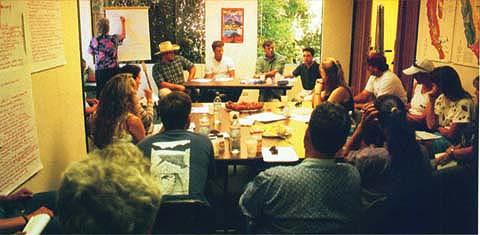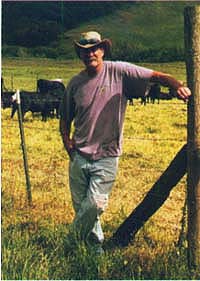All Issues
Marin ranchers bullish on grass-fed livestock
Publication Information
California Agriculture 56(5):151-151.
Published September 01, 2002
PDF | Citation | Permissions
Full text
While demand for grass-fed meats has increased in recent years, current media attention has spurred a flurry of interest that has been a boon for ranchers pursuing this niche market.
“We've been unbelievably busy since March 31, when Michael Pollan's article appeared in the New York Times Magazine,” Mike Gale of Chileno Valley Natural Beef told a group of ranchers at a recent meeting hosted by UC Cooperative Extension in Marin County. “We've doubled our production.”
The New York Times feature followed a Midwestern steer from birth to slaughter, detailing its feedlot regimen of limited exercise, growth hormones and fattening on corn. Since cattle are ruminants, their digestive systems are not accustomed to grains, making them more prone to disease; as a result, they need regular doses of antibiotics.
Grass-fed livestock, while not necessarily certified as organic, is raised almost entirely on pasture, and cattle usually do not receive hormones or antibiotics. As a result, beef fatten much more slowly. “It's a whole different way of thinking, as a rancher,” Gale said.
Beef cattle are still among the top commodities in California, but the industry is facing increasing challenges due to trends such as packer consolidation ( see p. 152 ). Grass-fed meats comprise a miniscule but growing portion of the state market. To assist ranchers who may want to take advantage of this opportunity, Steve Quirt, Marin County's newly hired organic and sustainable agriculture coordinator, convened the Natural and Organic Livestock Workgroup in mid-2002. (A grant from the Marin Community Foundation will help fund the effort.) About 20 ranchers gathered at the June meeting in Novato.
Travis Potter of Prather Ranch, near Mt. Shasta, described the operation's pioneering approach to raising and marketing certified organic beef, veal and other natural meat products. Prather uses diatomaceous earth and organic garlic to reduce parasites, and walnut husks for deworming. The beef is dry-aged for 3 weeks and freeze-frozen and vacuum-packed, then sold primarily directly to consumers at Northern California farmers' markets. “We're selling as much as we can,” Potter said.
Quirt said Marin County's grass-fed industry is also working under “a new paradigm of marketing meat directly to consumers.” A similar type of local marketing effort is under way in six Sierra Nevada counties, coordinated by UCCE advisors for Plumas-Sierra and Placer counties.
Steve Quirt In Marin County, UC Cooperative Extension convened the Natural and Organic Livestock Work Group to help local ranchers explore opportunities for marketing grass-fed meats. Addressing the group, left to right, are: Travis Potter, Prather Ranch; Dave Evans, Marin Sun Farms; Mike Gale, Chileno Valley Natural Beef; and Erik Parks, Marin Sun Farms.
A different product
Proponents believe there is evidence that grass-fed beef is less fatty and contains more vitamins and antioxidants than corn-fed, but widespread public acceptance will nonetheless be a major challenge. Grass-fed beef is much more expensive and is generally seasonal, as most ranches slaughter in the late spring. Furthermore, it tastes different than corn-fed beef, and may have fat marbling that is more yellow than white. Erik Parks of Marin Sun Farms said it is leaner and should be prepared differently.
“Because it has smaller muscle fibers, it shrinks much faster,” said Parks, a fifth-generation North Coast rancher who graduated from the Culinary Institute in New York. To prevent toughness, he recommends searing grass-fed beef on the outside, then cooking on a lower heat and allowing it to rest before serving.
The Marin County ranchers are hoping to bank on their close proximity to environmentally and health-conscious Bay Area consumers and restaurants, as well as the county's unique and specialized microclimate, with a long, cool, grassland growing season that is ideal for livestock. The UC-sponsored workgroup will study the possibility of forming a Marin County grass-fed meat association and cooperating on a mobile slaughter unit. They would also like to develop local standards for natural, pasture-finished and grass-fed meats, so that consumers understand exactly how the animal was raised.
“Consumers really need to believe that there's something behind these terms,” Gale said. “When it all boils down, all we have is our integrity.”






